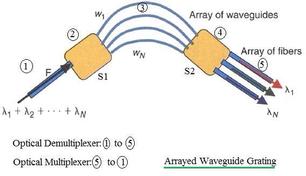10 Optical Communication Interview Questions & Answers
Advertisement
Optical communication, also known as optical telecommunication or simply optical networking, is a method of transmitting information using light signals. It involves the generation, modulation, transmission, and reception of optical signals typically in the form of laser or light-emitting diode (LED) beams.
Optical communication is widely used for high-speed data transmission over long distances and is a critical technology in modern telecommunications networks and data centers. Optical communication is widely used in telecommunications networks, internet infrastructure, and data centers to handle the ever-increasing demand for high-speed, high-capacity data transmission. It plays a crucial role in supporting the digital age’s connectivity and information exchange needs. Following is the list of questions and answers on Optical Communication. This questionnaire will help one pass the job interview for various fiber optic engineer positions.
Optical Communication Questions and Answers
Question - 1 : What is optical communication, and how does it work?
Answer - 1 : Optical communication is a method of transmitting information using light as the medium. It involves the modulation of light signals to encode data, which is then transmitted through optical fibers. These signals are received, demodulated, and decoded at the receiving end.
Question - 2 : What are the key advantages of optical communication over traditional copper-based communication?
Answer - 2 : Optical communication offers higher data rates, longer transmission distances, immunity to electromagnetic interference, and lower signal loss compared to copper-based communication. It is also more secure and less susceptible to signal attenuation.
Question - 3 : Explain the concept of total internal reflection in optical fibers.
Answer - 3 : Total internal reflection occurs when a light ray traveling within an optical fiber hits the core-cladding interface at an angle greater than the critical angle. Instead of being refracted out of the fiber, the light is reflected back into the core, allowing for guided propagation.
Question - 4 : What are single-mode and multi-mode optical fibers, and how do they differ?
Answer - 4 : Single-mode fibers allow only one mode of light to propagate, which results in higher bandwidth and longer distances but requires more precise alignment. Multi-mode fibers allow multiple modes, providing lower bandwidth and shorter distances but easier alignment.
Question - 5 : What is the significance of dispersion in optical communication, and how is it mitigated?
Answer - 5 : Dispersion is the spreading of optical signals as they travel through the fiber, causing signal distortion. It can be mitigated through dispersion compensation techniques such as chromatic dispersion compensation and dispersion-shifted fibers.
Question - 6 : What are optical transmitters and receivers, and what role do they play in optical communication?
Answer - 6 : Optical transmitters convert electrical signals into optical signals for transmission, while optical receivers convert incoming optical signals back into electrical signals for processing.
Question - 7 : What are the different modulation techniques used in optical communication, and when are they applied?
Answer - 7 : Common modulation techniques in optical communication include Amplitude Shift Keying (ASK), Frequency Shift Keying (FSK), and Phase Shift Keying (PSK). The choice of modulation depends on factors like data rate, signal quality, and available optical components.
Question - 8 : Explain the concept of Wavelength Division Multiplexing (WDM) in optical communication.
Answer - 8 : WDM is a technique that allows multiple optical signals of different wavelengths (colors) to be transmitted simultaneously over a single optical fiber. It significantly increases the capacity of optical communication systems.
Question - 9 : What is optical amplification, and why is it essential in long-haul optical communication?
Answer - 9 : Optical amplification involves boosting the optical signal’s power without converting it to an electrical signal. Erbium-Doped Fiber Amplifiers (EDFAs) are commonly used for this purpose, enabling long-distance transmission without frequent signal regeneration.
Question - 10 : What are the challenges and future trends in optical communication technology?
Answer - 10 : Challenges include reducing signal losses in optical fibers, developing faster optical components, and addressing security concerns. Future trends involve the deployment of optical communication in data centers, 5G networks, and emerging technologies like quantum communication.
Advertisement
 RF
RF







